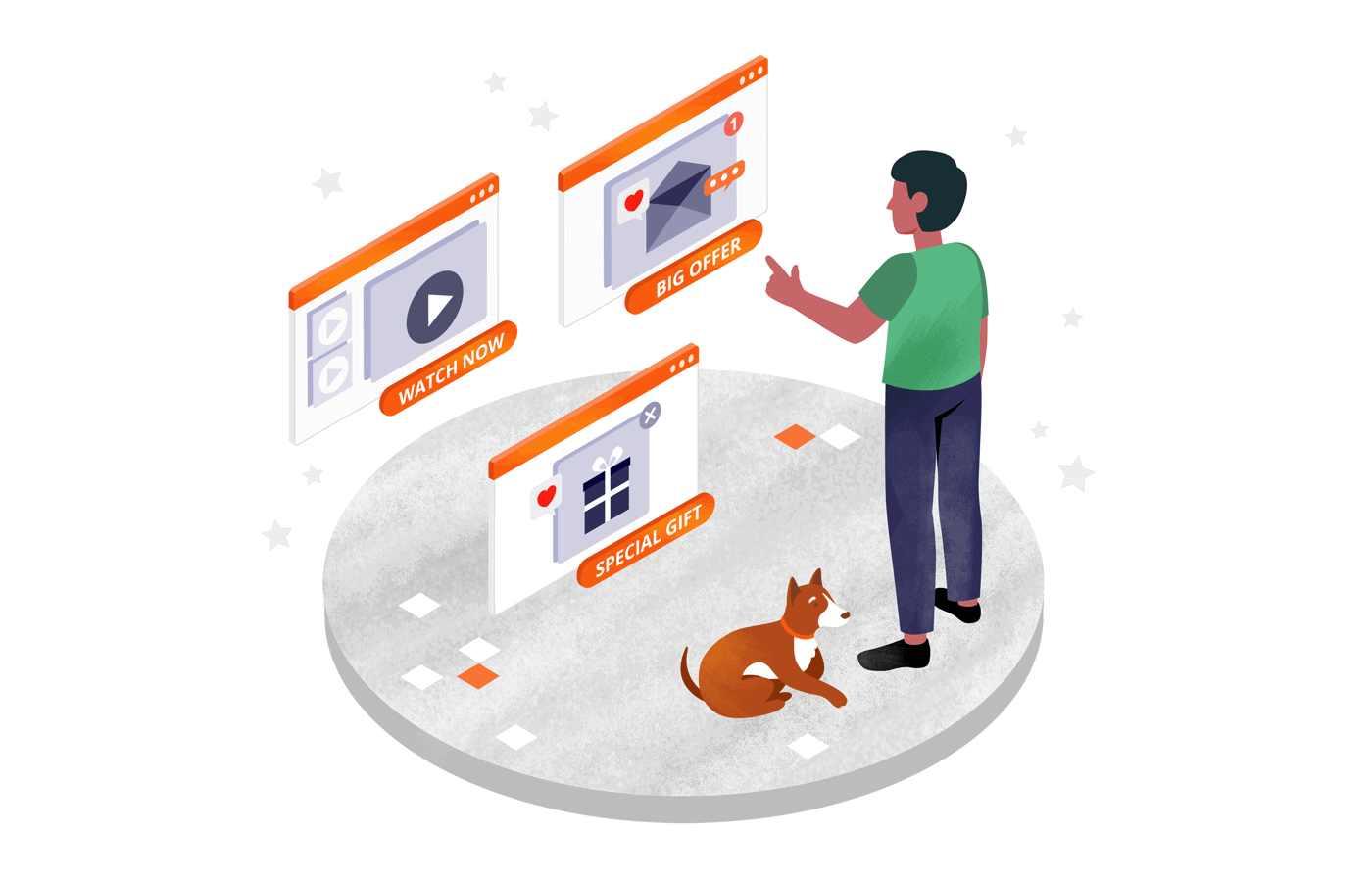If you breathe, see, hear, and walk, you might encounter between 6,000 and 10,000 ads daily. From billboards to social media ads, we’re surrounded 24/7. They’re all part of marketing campaigns, coordinated efforts to promote a product, service, or brand using various marketing channels.
There’s little doubt that any business could survive today without marketing. So a basic understanding of all the marketing and advertising campaigns available is crucial.
That’s precisely what we’ll cover in this article. Plus, we’ll share some great examples to fuel your marketing brain and critical elements of successful marketing campaigns that you can adapt to your goals and target audience. But first, what exactly is a marketing campaign?
What is a Marketing Campaign?
Briefly, a marketing campaign is a strategic sequence of steps and activities promoting a company’s product or service with a specific goal.
However, as with any story, there’s so much more to uncover, as marketing campaigns include:
- Promotion of products, services, brands, or ideas. Marketing campaigns are designed to create awareness, generate interest, and encourage action related to the promotion;
- Targeting specific audiences. They aim to reach particular demographics, psychographics, or customer segments that might be interested in or benefit from the promotion;
- Usage of various marketing channels. Marketing campaigns can occur across diverse platforms such as social media, email, advertising, content marketing, and different other channels;
- Clear objectives. Each campaign has a specific goal: increasing brand awareness, driving sales, generating leads, launching a new product, or other;
- Developing creative content and messaging. Campaigns are inseparable from compelling and engaging content that resonates with the target audience and conveys the desired brand image or value proposition;
- Implementation of measurements and analysis. There are also mechanisms involved to track and measure performance metrics. It allows for evaluating the campaign’s effectiveness and optimization based on insights gained from data analysis.
Key Parts of a Successful Marketing Campaign
Now that you have seen the best examples of different types of marketing campaigns, you might be itching to turn your successful marketing campaign into a reality. Yet, remember that it depends on the process, not the destination – to build a marketing strategy, you need to consider what a campaign should include.
In other words, the key elements:
- Clear objectives. Before anything else, you should set a goal you want to achieve with your marketing campaign. It’ll help you stay focused and move in the right direction;
- Target audience. Understand what drives your audience to action. Only once you know their pain points, needs, and interests will you be able to create purposeful messaging;
- Unique selling proposition (USP). Find what makes your product or service better than competitors and leverage it to stand out;
- Messaging. When you know why and what you want to say to a specific audience, craft a message that tells why they need your brand;
- Creative assets. Think which visual and multimedia elements would be best at bringing your campaign’s ideas and messages to life;
- Channels and tactics. Where and how you employ your marketing campaign may make or break the success of it. Consider which choices would be the most beneficial for your specific situation;
- Budget and timeline. Ensure your company is ready for your set marketing budget and has the time and energy to carry out the marketing campaign effectively;
- Measurement and analytics. Collect, analyze, and interpret your campaign’s data to understand how well it’s doing and what you can do to improve it.
17 Types of Marketing Campaigns
In a marketing context, you have (almost) endless campaign possibilities. If you’re starting out, finding the best choice for your brand and goal might be confusing.
That is why we’ve compiled a list of marketing campaign types to ease your first steps. Including the best marketing campaign examples!
Social Media Campaign
If you’re one of 5.7 billion social network users worldwide, we bet you saw at least one social media marketing campaign before stumbling on this blog post. Due to its broad reach, targeted advertising capabilities, and cost-effectiveness, it’s one of the most popular types of advertising and marketing campaigns.
Simply put, social media campaigns promote products, services, or brands through social media platforms like Facebook, Instagram, X (former Twitter), TikTok, and other platforms to increase engagement and boost sales.
It can happen organically when the marketing campaign spreads among and beyond your followers for free. However, in recent years, organic reach has been on the decline. So, more often than not, brands boost their message with paid advertising to ensure it reaches their target audience.
Good Coca-Cola Example
The popular Coca-Cola “Share a Coke” campaign isn’t only an example of an effective social media marketing initiative. It’s one of the best marketing campaigns of all time.
The campaign’s idea was straightforward yet clever: the brand’s famous logo was replaced with words, usually names, suggested by people. Then, Coca-Cola urged its fans to post pictures of themselves holding customized Coke bottles on social media with the hashtag #ShareACoke. Needless to say, this digital marketing campaign went viral overnight.
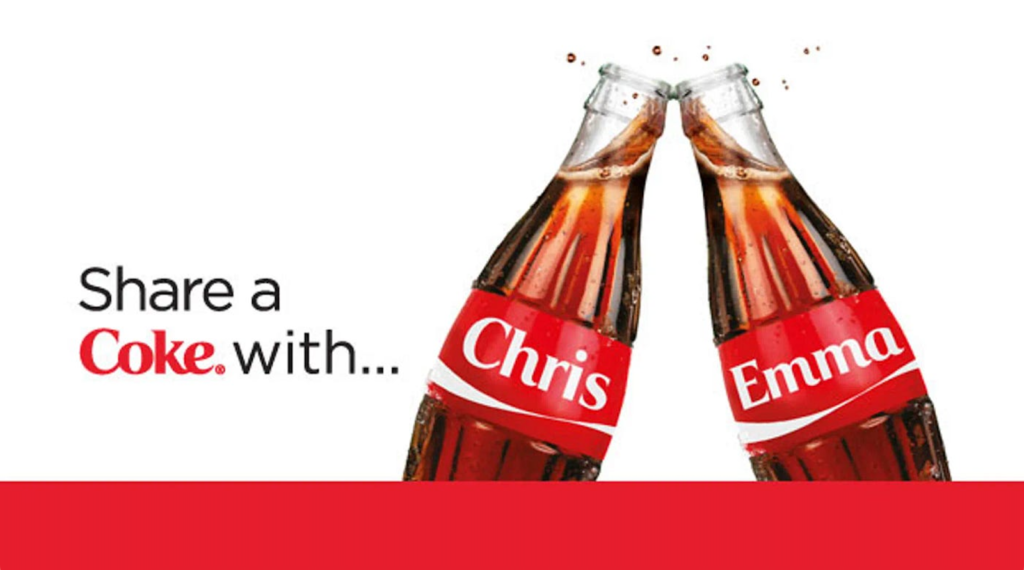
Why it works:
- The idea is easy to comprehend from the first glance and thus easy to interact with;
- Possibility to personalize is unbelievably alluring;
- The campaign involves the brand’s fans boosting engagement to unseen heights;
- It promotes word-of-mouth, achieving higher reach (globally, actually).
Email Marketing Campaign
Another popular type of digital marketing campaigns is an email marketing campaign. And for more than one good reason! Not only are there 4,481 million email users worldwide (what an audience potential!), but email marketing can also bring ROI up to 4800% (that’s $48 for every $1 spent).
An email marketing campaign involves sending a series of marketing efforts to multiple people simultaneously. When done right, it’s a great way to grow your business, drive traffic, and increase sales.
You might have heard that email marketing is dying, but it can’t be further from the truth.
In fact, this direct marketing channel remains one of the best ways to connect with your audience and sell your product or service. It meets your customers right in their inbox, allowing personalized communication that resonates. Plus, it consistently outperforms other marketing channels in engagement and conversion rates.
Good AllTrails Example
AllTrails understands that when you send your email is as important as what you include inside. So, they initiated the inbox communication with a warm message welcoming the new user just after subscribing. While the welcome email doesn’t sell anything, it has a crucial purpose – to create a good relationship with its customers and let it blossom into loyalty in the long run.
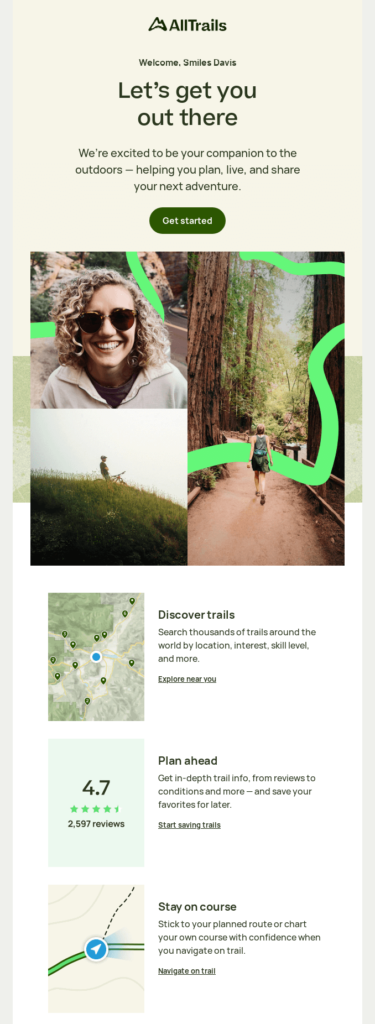
Why it works:
- The welcome emails make a good first impression and set the tone for future communication;
- It makes the subscriber feel like they’ve made the right choice and stick with the company;
- It simplifies the onboarding process, minimizing the risk of the customer leaving the brand;
- The welcome email is also personalized with the subscriber’s name, making it more engaging.
Start your customer relationship on the right foot and see it blossom into conversions and loyalty with email marketing. Sender makes it easy.
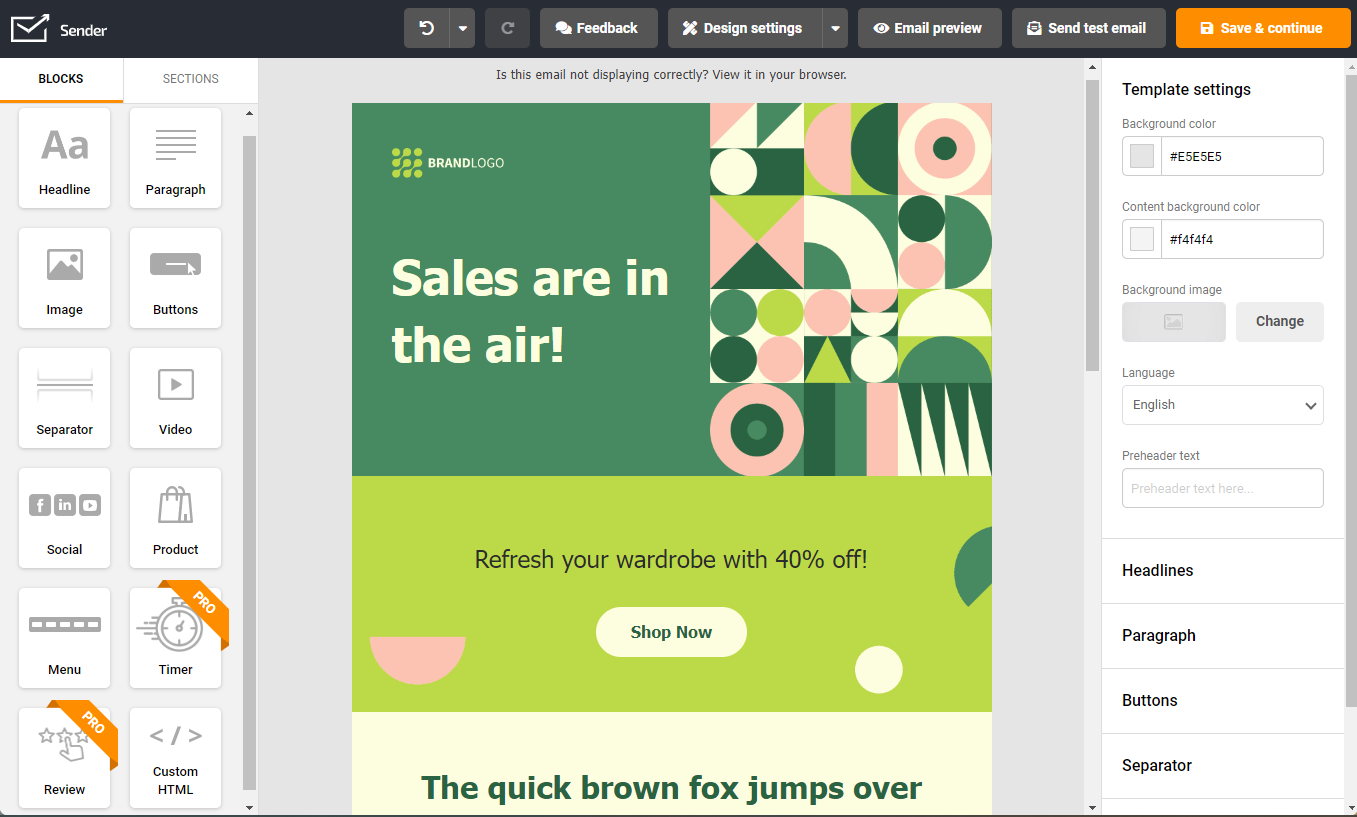
Even better? You can choose a Free Forever plan and send up to 15,000 emails monthly to 2,500 subscribers!
Find out more about successful email marketing campaign examples.
Content Marketing Campaign
Not all marketing campaigns are like a flashing neon sign. Did you stop and think this blog post might be a part of the marketing effort, too? It’s called content marketing and includes creating and distributing relevant and valuable content designed to attract and retain an audience.
Instead of pushing a brand or product, content marketing is all about sharing helpful info, engaging content, or inspiring stories to connect with and teach the audience you’re trying to reach.
Content marketing campaigns come in different sizes and shapes, too! Think articles, videos, podcasts, infographics, ebooks and more. In fact, everything goes as long as the audience can take something valuable from the content.
Good School of Life Example
School of Life sells various personal growth-related products and services, from books to therapy retreats, yet you won’t find a single promotional message in their blog posts. Instead, it focuses on providing their audience with relevant content that helps their life fulfillment goal. Nevertheless, this strategy works well as intrigued website visitors are likely to purchase.
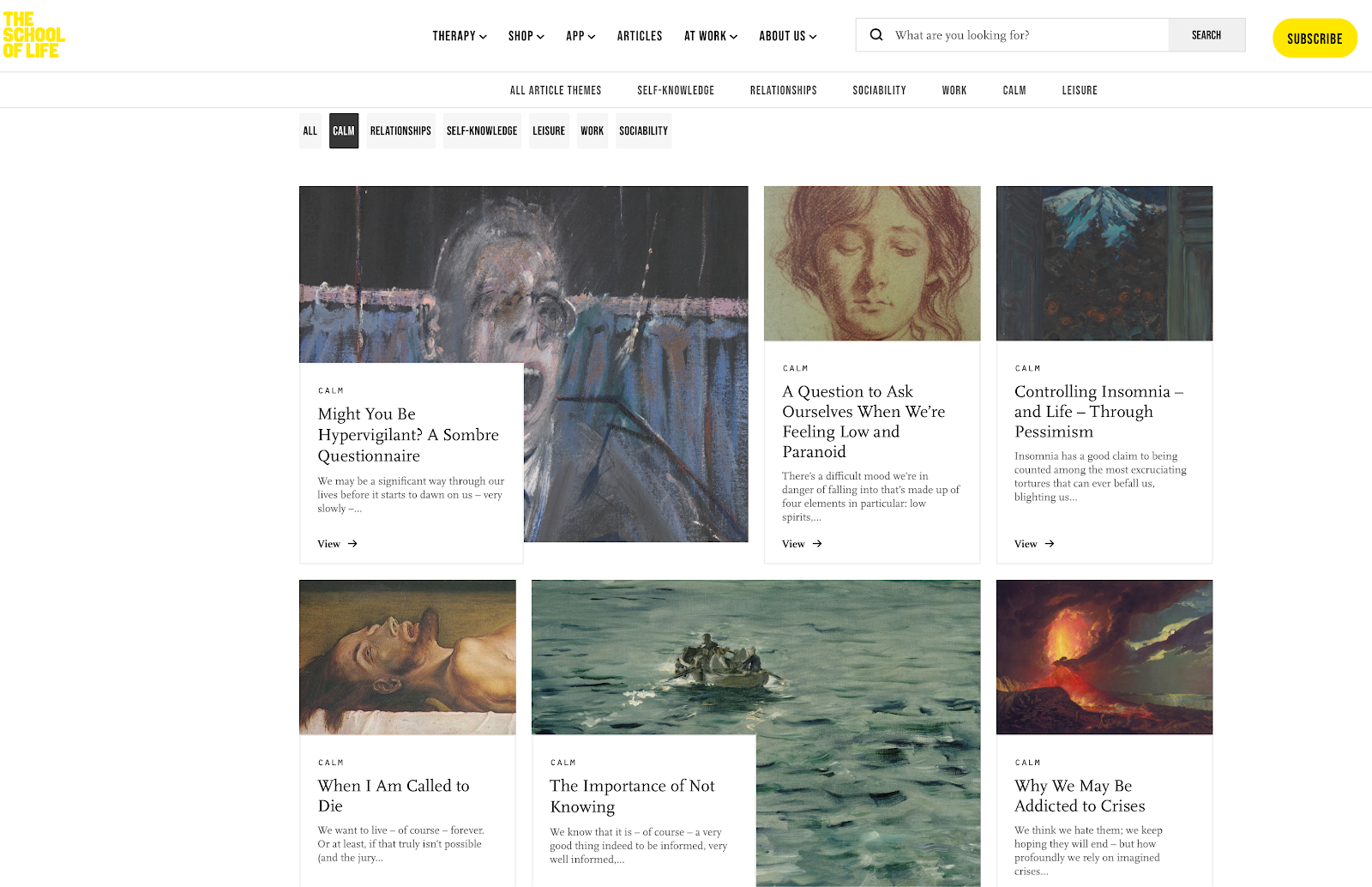
Why it works:
- The blog articles give the users exactly what they need – relevant content and answers to their pain points;
- The site visitors can filter the article themes, allowing them to find the content they’re most interested in more easily;
- Each article also has a preview snippet to simplify the navigation and, in return, lengthen the engagement time;
- School of Life also has a YouTube channel covering similar themes for users who prefer to consume content differently.
Rebranding Campaign
No business will get very far without a brand identity. A good brand is easy to recognize and notice in the marketplace. However, what worked yesterday might not work today—current branding needs a makeover.
That’s where rebranding, a marketing strategy aimed to change how it presents itself to the public, comes into play. It involves changing your brand from the ground up: logo, slogan, concept for your company, and sometimes even a new brand name.
So when do brands decide that they need a retouch? There are many reasons, from international expansion or moving into another industry to merger, acquisition, or demerger. However, the most common need comes from time. After years of working in one industry, a switch-up in branding and communication simply makes sense.
Good Burger King Example
Why would a well-established brand want to completely rebrand after 20 years? Well, in those decades, Burger King has worked to achieve the highest standards for food quality, sustainability, and restaurant experiences. The old visual identity simply holds back this message.
Burger King’s global rebrand signifies an important change—a shift from a synthetic, artificial brand to a restaurant with real, craveable, and tasty food.

Why it works:
- The rebranding campaign is loud, making sure that its announcement creates waves;
- It not only changed the brand’s visual identity but also spoke about its changed goals and values;
- The new visual identity was based on retro Burger King designs, ensuring the brand stays recognizable.
Retention Marketing Campaigns
The idea behind retention marketing is that having ten brand fans rather than 100 one-time customers is more valuable. They might have purchased once and maybe even spent a lot, but only loyal customers will keep coming back, buy for their family and friends, and pass on the word about your brand.
That’s why customer retention marketing is irreplaceable in fostering sustainable business growth and helps keep marketing costs in check. In fact, acquiring new customers is 6-7x more expensive than getting existing customers to make repeat purchases.
So, what’s retention marketing, exactly? Put simply, it’s the strategies and tactics for nurturing and maintaining customer relationships. Examples include loyalty programs, personalized communication, re-engagement campaigns, and similar strategies.
Good Amazon Example
If you’re looking for a great retention marketing strategy, look no further than your internet search history. No one does it like Amazon. The brand has been cracking customer retention for years, reaching an all-time high with a 93% retention rate after the first year and 98% after two years.
While the brand has plenty of retention tricks up its sleeve, one is all-too-familiar: personalized customer experience, where Amazon has really set the bar high. Just think about those personalized recommendations you’ve received after purchasing an item. You did consider them, didn’t you?

Why it works:
- The recommendations are highly personalized based on the customer’s past purchases;
- They are placed on a dedicated page, making sure that they aren’t intrusive;
- The recommendations are dynamic, meaning they change if the customer is not interested.
UGC Marketing Campaign
Suddenly, a notification comes to your phone—a friend tagged you in an Instagram picture from last night’s dinner. You open it and see that they’ve also tagged the restaurant. That picture right there just became user-generated content (UGC), the genuine portrayal of daily brand affection that is taking over social media marketing.
UGC is unpaid or unsponsored content your customers create related to your brand. It can be reviews, photos, videos, social posts, or any other authentic content.
Such content helps you create credibility. But even more importantly, UGC lets you connect with an audience beyond your own brand, as shared content shows others that people are loyal to your brand.
Good ASOS Example
ASOS cracked the social media campaign code and created a feed of free advertising for their clothes with UGC.
In 2014, the brand launched the #AsSeenOnMe hashtag on Instagram, encouraging customers to upload pictures of themselves wearing clothing bought from the online store. Little did they know that the campaign is still going strong today and has an impressive engagement rate.
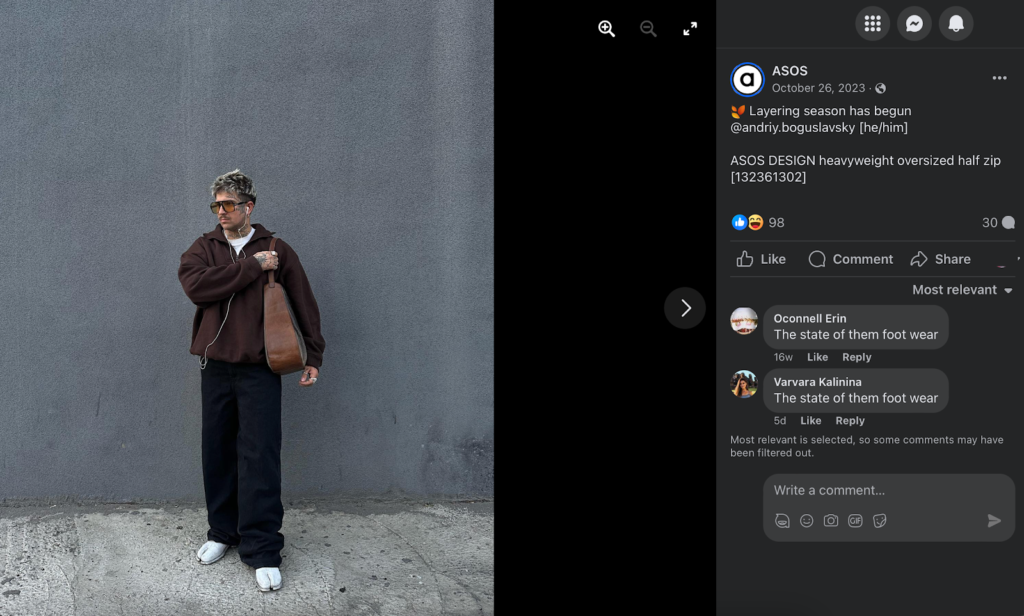
Why it works:
- ASOS implemented their marketing efforts where their audience is already hanging most of the time – on social media;
- The brand made its customers the center of their social media marketing campaign, making it ever so powerful;
- The audience feels naturally inclined to share ASOS content, building brand awareness;
- Seeing how “real people” benefit from a brand’s products encourages prospects to try it.
Brand Awareness Campaign
Not all marketing campaigns are aimed at driving immediate action. Some have the sole purpose of improving your brand’s recognizability. In other words, to ensure that your ideal customers have the right impression about your brand and it’s strong. Or, at the very least, make your potential customers notice you.
Additionally, a successful brand awareness campaign will make your audience associate your company with a particular product or service, visual or audio logo, or even a color (think the Golden Arches). Such recognition can lead to successful relationships with customers based on trust. And you know what trust builds – loyalty.
However, building brand awareness is no small feat and rarely happens overnight on one marketing channel. It takes a long-lasting integrated marketing campaign to notice tangible results, and it never stops. Nevertheless, the payout is worth it, as the example below proves.
Good Nike Example
Out of all the creative campaigns, you definitely know this one. So well, you’d be able to answer ‘Just Do It’ when woken up with the question “What’s Nike’s slogan?” in the middle of the night. But why?
The company launched its “Just Do It” campaign in 1988 and since then promoted it in every way imaginable. Combine it with a powerful message meaning – Nike provides you with athletic motivation – and you have a winning brand awareness campaign that creates an almost unbreakable emotional connection with your target audience.
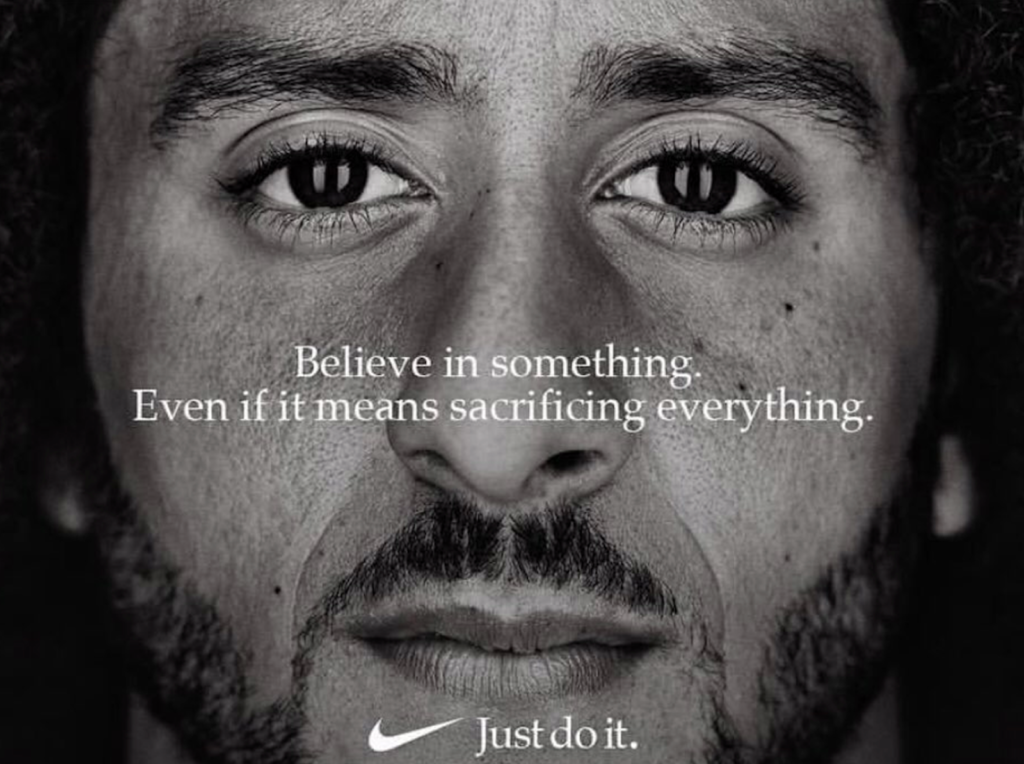
Why it works:
- The brand awareness campaign is tightly related to the brand’s products;
- The brand messaging is based on a strong benefit for the customer – athletic motivation;
- It’s simple, catchy, and easy to understand at first glance;
- The campaign has had various forms and modified messages to resonate with different groups of people.
Sales Promotion Campaign
Sales promotion campaigns are designed to motivate customers to purchase and drive product or service sales within a timeframe. They use various promotional tactics: discounts, coupons, limited-time offers, contests, giveaways, loyalty programs, bundled deals, rebates, etc. These tactics aim to remove customers’ objectives for purchase (price, shipping costs, etc.) and motivate them to act by creating a sense of urgency.
Aside from driving sales, sales promotion campaigns aim to increase product visibility, attract new customers, and encourage repeat purchases. These campaigns are often part of a broader marketing strategy and strategically coincide with seasonal trends, holidays, product launches, or other relevant events.
While sales promotions are usually successful in quickly driving sales, they should be used sparingly as frequent sales devalue a brand and make it harder to sell products at regular prices in the future.
Good Adidas Example
Even such multibillion-dollar brands as Adidas aren’t immune to launching sales. However, what’s different is how it does it.
Occasionally, the brand launches a sale aimed at their membership program adiClub’s members only. This is an ingenious tactic for two reasons. First, since the members are often the most frequent buyers, an additional incentive to purchase almost guarantees that they do it. Second, such limited access ensures that the select group feels exclusive and further fosters loyalty.
It is even better that this sale is on the brand’s homepage, making it visible to every visitor and motivating them to become adiClub members, too.
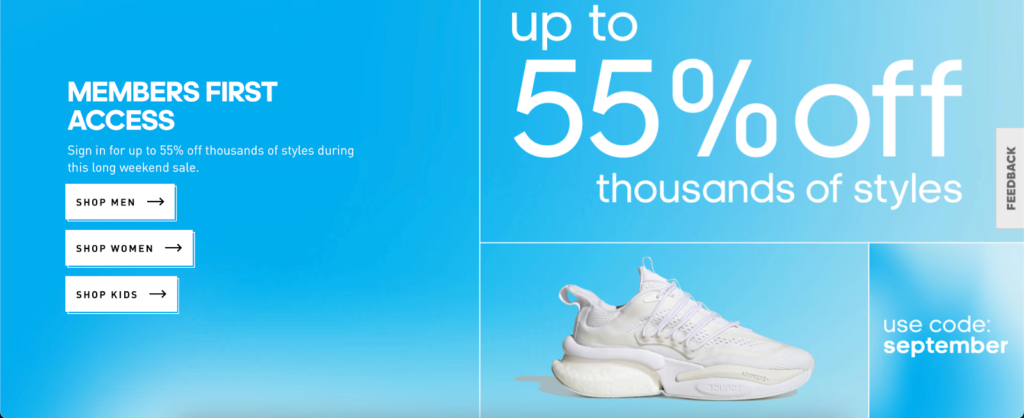
Why it works:
- The exclusivity of the members is highlighted for both them and regular site visitors;
- The offer is limited to the long weekend period, creating a sense of urgency;
- Three segmented CTAs enhance visitors’ experience without overwhelming them.
SEM Campaign
A SEM (Search Engine Marketing) campaign combines paid advertising with search engine optimization (SEO) techniques to boost your website’s visibility and attract more visitors from search engines:
SEO
Search engines like Google use sophisticated algorithms to determine which websites to display first in search results. By creating high-quality content and earning links from other websites, you climb higher rankings, surpassing your competitors.

Paid advertising
Paid advertising, often called PPC (Pay-Per-Click) or CPC (Cost-Per-Click), involves bidding on specific keywords to appear when people search for those keywords. This type of ad campaign is usually done through platforms like Google Ads or Bing ads and incurs a small fee every time your ad is clicked.
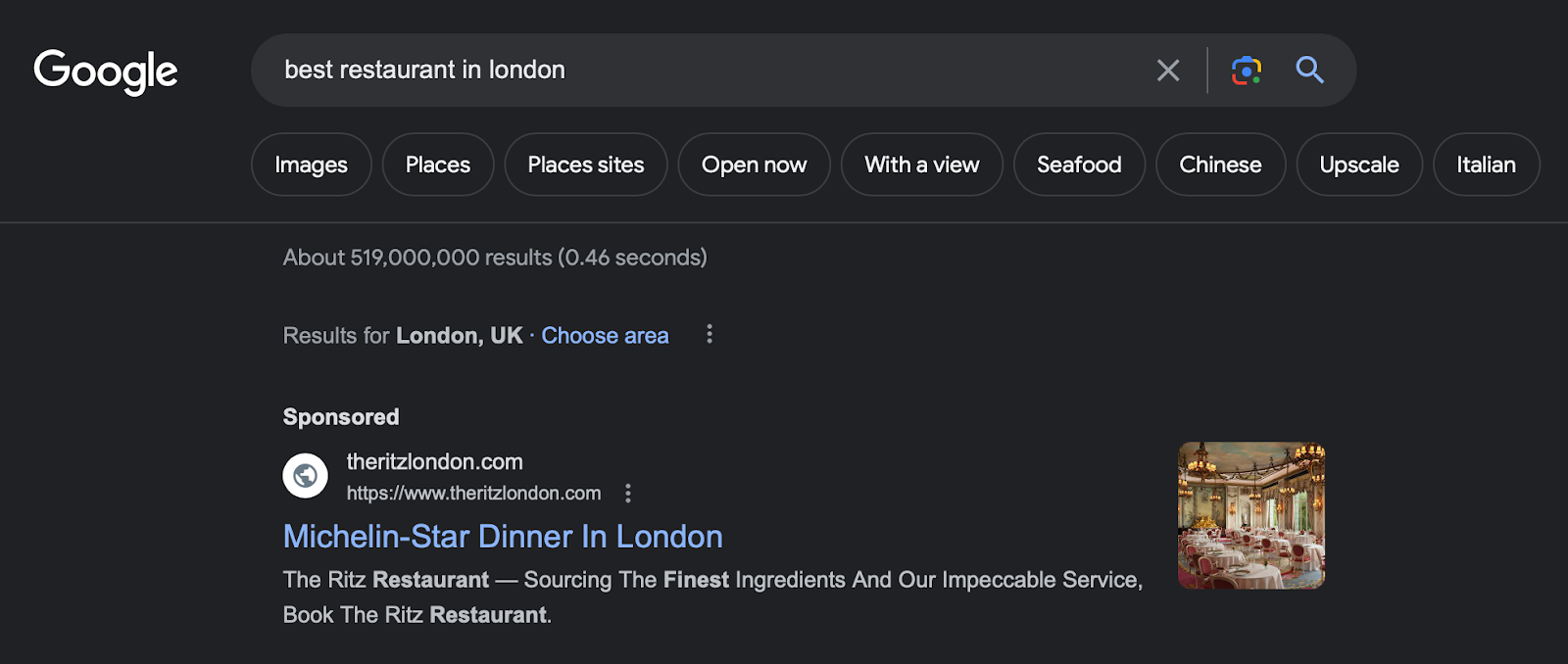
Using SEO and paid advertising together, you can reach more people and drive more traffic to your website.
Good HoneyBook Example
PPC ads are a highly competitive area. Most searched keywords are the most sought after by companies and, thus, the most expensive. So, often, the brands have to decide whether targeting it is worth the money. But what do you do if it isn’t? Follow the HoneyBook’s example and find a creative solution.
HoneyBook is bidding on the brand name of its competitor, FreshBooks. It lets them show off its features and benefits before clicking on a competitor’s link. While such a tactic’s tastefulness is arguable, it works well, demonstrating the brand’s personality and value.
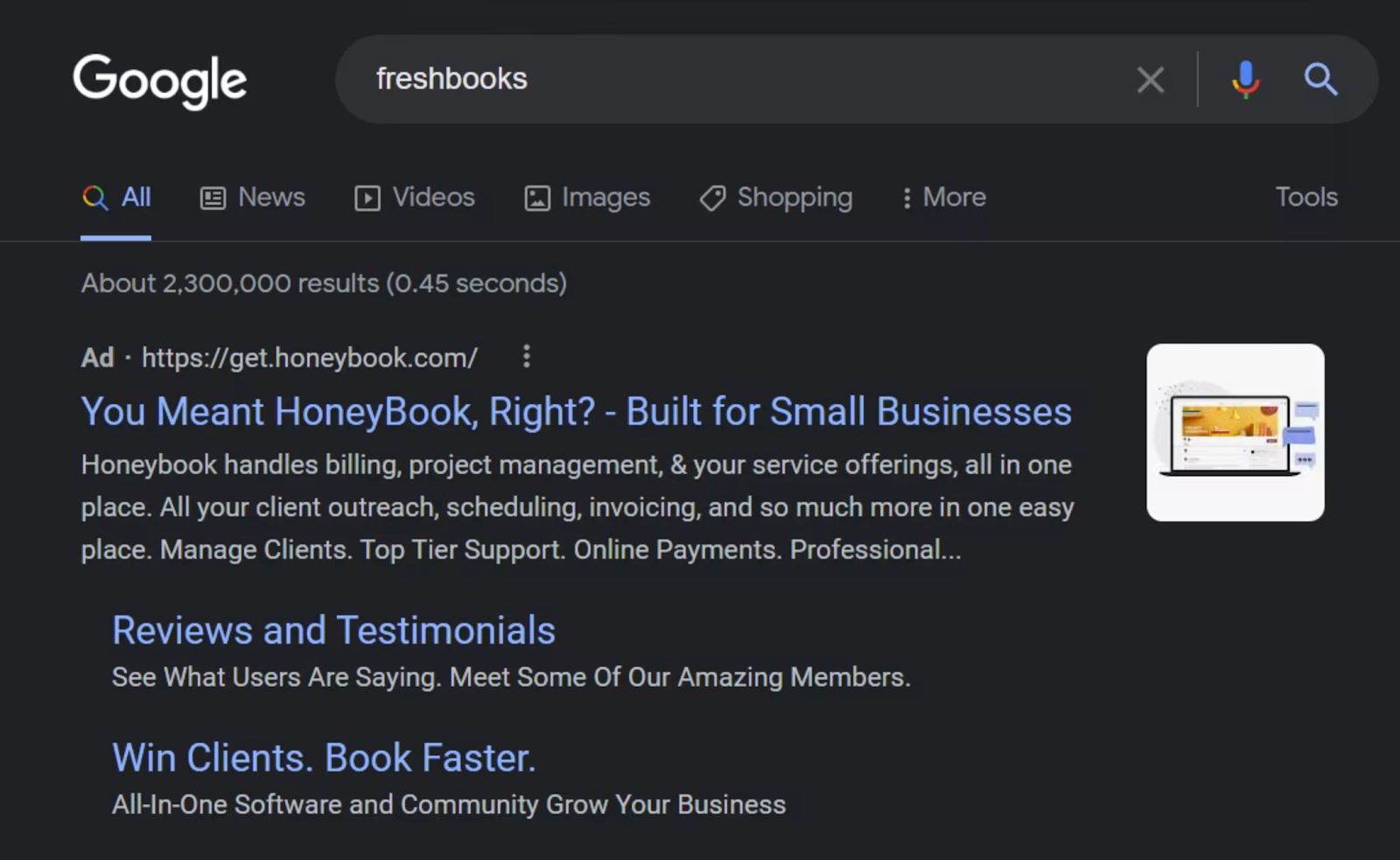
Why it works:
- The brand killed two birds with one stone: using their competitor’s brand name as a keyword reduced its ad cost and positioned it higher in the search results;
- The ad directly addresses what features make them better than FreshBooks;
- Using site links, an automated Google Ads extension that displays links deeper into the site, allows the brand to touch more value points, enhance users’ navigation experience, and push competing ads further down.
Product Launch Campaign
A product launch campaign is about unveiling a new product or service to the market. Using multiple channels like social media, email, and PR aims to get people excited, build up anticipation, and ultimately drive sales when the big day arrives.
A successful product launch campaign isn’t just about making a splash on day one but laying the groundwork for long-term success. That means standing out from the crowd, carving out your niche in the market, and ensuring your product shines bright even after the initial hype dies down.
Any great product launch campaign starts with some serious preparation. That means diving deep into market research to figure out who your audience is, what they’re looking for, and how your product stacks up against the competition.
Good Apple Example
When it comes to product launches, Apple sets the bar sky-high. For over two decades, the world eagerly anticipates their annual Apple Event, where the brand unveils its latest innovations and services.
But what makes Apple Events so extraordinary? It’s not just about unveiling products; it’s about crafting an unforgettable experience. With a winning formula of anticipation, captivating storytelling, and live demonstrations, Apple keeps its audience on the edge of their seats.
What’s their secret sauce? It’s the perfect blend of simplicity and user-focused design sprinkled with surprise and delight. At Apple Events, attendees are in for a treat – they can always expect the unexpected.
Why it works:
- Apple Event has built a reputation of being extraordinary and, by delivering the promise each year, continues to arouse curiosity;
- The brand creates a sense of intrigue way before the product launch by slowly revealing details and building suspense that the event resolves;
- The product launch isn’t just about the products. It delivers its audience a sensory experience, making it ever so powerful;
- The event leverages an almost cult-like following of the brand, mirroring what made it famous in the first place: simplicity and user-centricity.
Getting ready for a brand new product launch? Learn how to write powerful product launch emails.
Lead Generation Campaign
Lead generation campaigns aim to attract prospects and convert them into customers through nurturing. It can be done both online (e.g., through Facebook ads) and offline (e.g., during a tradeshow), but their guidance towards your offers mainly happens online.
The lead generation usually starts with a hook – some goodie to draw the prospect’s attention. Once they show interest in the company, they’re warmed up to the brand and more willing to hear what it offers. While time-consuming, it’s a more natural way to convert a stranger into a customer than to simply push them to do it.
Lead generation campaigns often employ a multichannel approach, using platforms like email, social media, blog content, and popups to engage with prospects and nurture them through the sales funnel.
Good Zapier Example
Nothing grabs a prospect’s attention like the word “free.” That’s why free trials and freemium subscriptions are a great way to generate leads. Understanding this, Zapier offers a free trial as the first thing on its homepage. But why does it work?
Zapier’s free trial allows prospects to try out the product without any strings attached, nor do they have to spend money or speak to a salesperson. In exchange, Zapier is left with a lead that’s already warmed up at the end of the trial – they already have first-hand experience of the product and its benefits. From there, converting a prospect is easier.
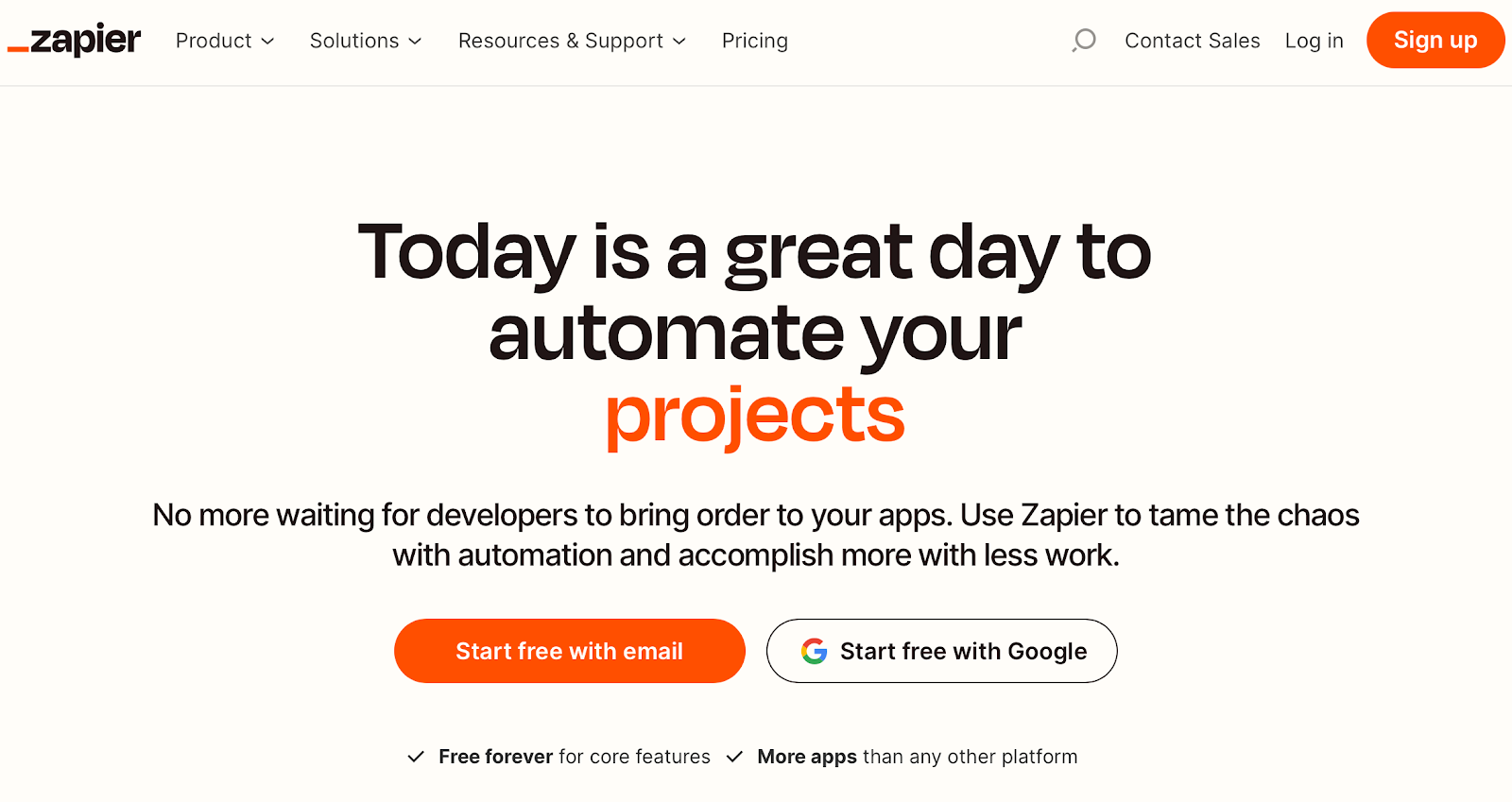
Why it works:
- The brand offers a valuable incentive to attract prospect’s attention;
- After the free trial, the prospect is already educated and warmed up to move down the sales funnel;
- Demonstrating its product’s benefits for a limited time creates a motivation for conversion.
Event Marketing Campaign
Event marketing is a way to promote a company and its products through events. Organizing or participating in events is a great way to showcase your capabilities, increase brand awareness, find partners, and build strong customer relationships.
One way event marketing helps to build customer connection is through positive emotions. If people spend fun and valuable time at an event thanks to your brand, they’re more likely to seek more interactions, whether learning about your brand or purchasing your products.
Event marketing can happen offline as live conferences, exhibitions, festivals, trade shows, etc., or online as webinars, virtual conferences, workshops, etc.
Good Sonos Example
When the wireless sound system company Sonos needed to announce its integration with Google Assistant, it knew it had to go all in. So it did.
The brand launched a three-day event where the visitors were immersed in a multi-sensory experience to demonstrate the physics, structure, and emotion that music can communicate. It helped the prospects better understand and have firsthand experience with the features of Sonos products – namely, high-quality audio and premium design.

Why it works:
- The visitors received an exclusive demonstration of Sonos product’s features;
- The event created a positive emotion, leading to a deeper connection with the brand’s audience;
- Due to its uniqueness, the event drew attention beyond its visitors.
Video Marketing Campaign
As the name suggests, a video marketing campaign is a digital marketing strategy where videos are used to promote products, services, brands, or messages. Its main advantage lies in visual storytelling, which is proven to be highly successful in engaging target audiences across various channels.
Video marketing is one of the fastest-growing components of digital marketing strategies, mainly because social media algorithms prefer video content on their platforms. But it’s not the only reason why marketers are turning their heads to marketing videos.
Video marketing campaigns can enhance brand awareness as social media platforms push short-form videos to larger audiences. Social media videos also get more engagement than other types of marketing content. And finally, having the advantage of time and space marketing videos can more effectively promote products, leading to better conversions.
Good Red Bull Example
You might have already seen this one since it racked up 21 million views on YouTube alone. Red Bull’s “Stratos” video is a feast for the eyes, but it’s not the main reason it was so successful.
The main reason is that Red Bull showed that it understood its audience of thrill-seeking people around its energy drinks and delivered them a storytelling masterpiece. While the video doesn’t directly promote the product, it strengthens the positive brand image, increasing its sales as a result.
Why it works:
- The high-quality footage and captivating visuals made the visual marketing campaign memorable;
- The video created an emotional connection with the audience through the main character’s story;
- The campaign is aimed at the long-term goal of increasing brand awareness, ensuring that it has a lasting impact.
Cause Marketing Campaign
A cause marketing campaign is a marketing method where for-profit businesses take on a social cause that’s related to them and create a campaign to promote it. It’s an effective way to improve the brand’s perception since it shows that the company is socially responsible and cares about the same issues as its audience.
Cause marketing campaigns effectively attract prospects and encourage them to learn more about the brand, as well as financially support its cause. Additionally, repeat customers who support the same causes are more likely to remain loyal to the business. Not to mention that a cause marketing campaign benefits the world, even if it’s a little.
Good Bombas Example
High-quality sock and apparel brand Bombas’ marketing strategy was to help those in need from day one. The same item a customer buys from the brand is donated to a homeless shelter. Given that the campaign’s products – socks and underwear – are the top requested items, it makes the cause especially meaningful.
Since launching in 2013, Bombas has donated more than 100 million pairs of socks and other clothing essentials to those in need. It helped garner a wide, loyal customer base and continues to spread the word about the brand organically.
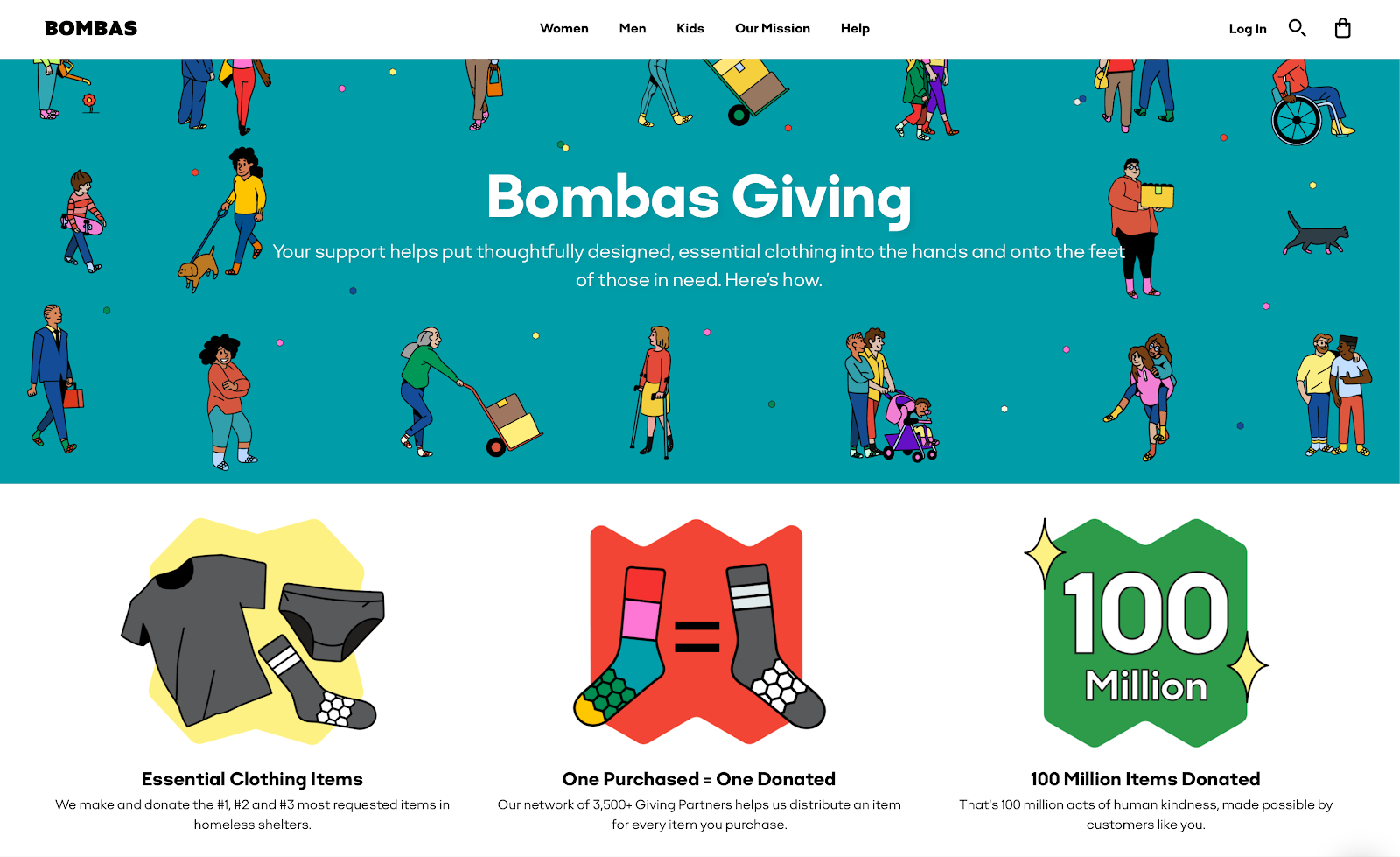
Why it works:
- Bombas’ cause marketing campaign benefits three sides: the brand, the customer, and those in need;
- It draws attention to a relevant cause and gives the customers a simple way to help solve the problem;
- Its social initiative also doubles as a unique value proposition, ensuring the brand stands out from its competitors.
Guerrilla Marketing Campaign
Guerilla marketing campaigns are unconventional and often low-cost promotional strategies that aim to generate maximum impact. Rather than promoting products and services, they count on creativity, imagination, and original tactics to reach a target audience unexpectedly.
It’s probably the most ambitious campaign in the bunch. No wonder it’s most popular among edgy brands that want to cause a stir.
Guerilla marketing campaigns can come in many forms, from street art and viral videos to publicity stunts, as long as they generate widespread attention and word-of-mouth promotion without spending large advertising budgets.
Good Furphy Example
Guerilla marketing campaigns are rare in the wild, but when you see one, it leaves a lasting impression. Such was Australian beer company Furphy’s ‘What the Truck?!’ recent, award-winning campaign.
To promote its Furphy Crisp Lager, the brand secretly wedged a 7.8-tonne beer truck between two skyscrapers in Sydney just to be found by dumbfounded commuters in the morning. However, due to its absurdity, the word about the campaign managed to spread beyond the country walls, and the pictures were shared all over the internet, increasing the brand recognition.
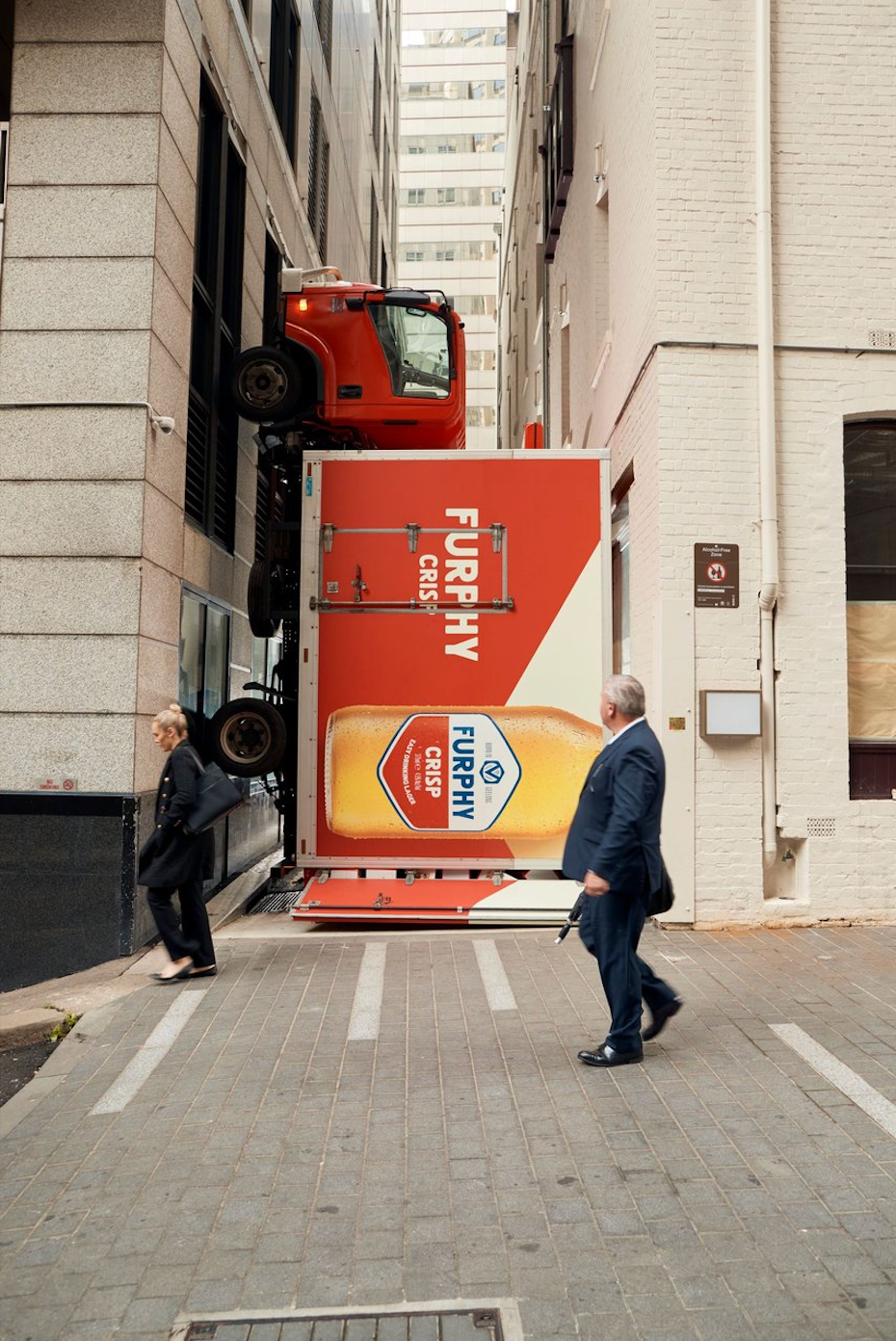
Why it works:
- The surprising activation drew much attention and got the brand noticed;
- The question ‘How did they do it?’ kept the brand’s name in its audience’s mouths for a long time;
- It’s supported with OOH (Out-of-Home advertising), radio, social, and digital activity to ensure an even broader and more substantial impact.
Influencer Marketing Campaign
An influencer marketing campaign is a collaboration where an influencer creates content for or on behalf of a brand. When done right, it results in authentic promotional content that drives credibility, awareness, and sales.
However, it’s not enough to only give a person who’s visible online your products and creative power. Successful influencer marketing campaigns count on authenticity, so it’s crucial that the chosen creator aligns with the brand and that their audience matches the brand’s target prospects.
While affiliate influencer campaigns and sponsored posts are the most popular types of influencer marketing campaigns, other brands also benefit from giveaways and product collaborations (though they require more long-term commitment).
A collaboration with influencers doesn’t have to be a one-time thing, as more and more brands are employing influencers as their brand ambassadors who constantly promote the brand’s products or services.
Good Gymshark Example
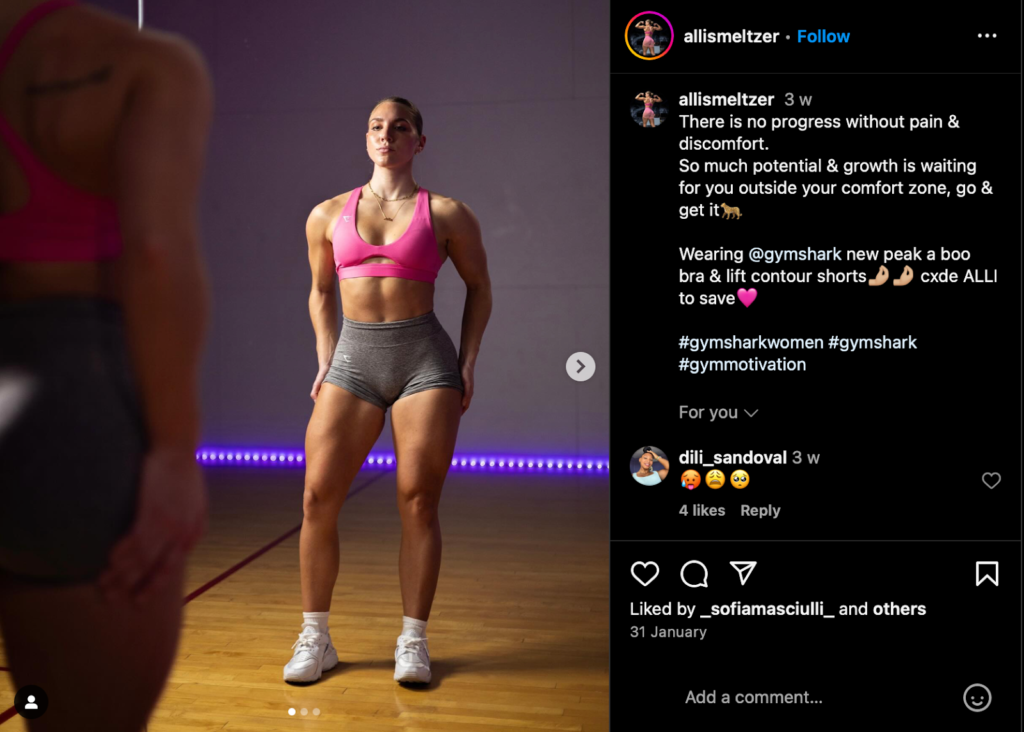
Influencer marketing is a big part of fitness apparel Gymshark’s marketing strategy, but it’s so much more than just promoting their products.
The brand nurtures a community spirit and empowers its intended audience by constantly posting quality content created with athletes and fitness motivation influencers wearing Gymshark apparel. This authentic portrayal forges a strong emotional bond and creates a genuine brand identity that grows its fanbase.
So, by purchasing the brand’s products, the customers get not only fitness apparel. They get to express their passion for fitness and join a close community.
Why it works:
- The brand employs influencers that fit with the brand’s image, ensuring authenticity and credibility;
- The content is aimed to motivate the audience rather than just promote the products;
- Additionally, the brand endorses followers to share their content, showing them wearing the apparel, further nurturing the sense of belonging in a community.
Mobile App Marketing Campaign
Let’s say you developed a revolutionary app that could change lives. Just believing that it’s great and telling a couple of friends won’t do any good in making it popular. What you need is mobile marketing. Without it, your app is lost among millions of others.
Mobile app marketing involves strategies and techniques to increase app visibility, drive installs, and foster user engagement, ultimately leading to your app’s success. More importantly, it entails constant fine-tuning of these methods to keep up with the trends and keep delivering sales.
Mobile app marketing does share basic similarities with ecommerce marketing, for example, in its reliance on user engagement and conversion optimization strategies. However, there are noticeable differences, too, such as app store optimization, in-app engagement, and more.
Good Candy Crush Saga Example
Candy Crush is one of the most successful gaming franchises of all time. Look around, and soon enough, you’ll start noticing people playing it while watching TV, commuting, or even at work. While the game’s addictive nature has something to do with it, its mobile app marketing should also be praised.
Last year, the gaming app burst out of phones and into the real world with immersive films that put players at the heart of its new campaign. The short films dramatized the moments when people played Candy Crush Saga and showed how the magic of the game transformed their world.
Why it works:
- The marketing campaign showcases the outcomes rather than the features of the app;
- Beautiful visuals make the campaign extremely appealing;
- The short films successfully passed the emotion of how it feels to play Candy Crush Saga.
Benefits of Marketing Campaign
No wonder businesses sacrifice a good portion of their budget for marketing! It can bring plenty of benefits you won’t get anywhere else:
- Building brand awareness. A marketing campaign can become your prospects’ first introduction to your brand and foster recognition in the long run;
- Generating revenue. By showcasing your products or services, you engage your customers and encourage them to buy from you;
- Building brand reputation. If you use marketing campaigns to emphasize values, quality, and customer satisfaction, you can expect more loyalty from existing customers and positive attention from potential ones;
- Providing insights into consumer behavior. Analytics tools, feedback mechanisms, and market research give you a deep understanding of your target audience’s preferences, pain points, and purchasing patterns, i.e., a goldmine of insights into refining your strategies;
- Maximizing ROI. Effective marketing campaigns are synonymous with high return on investment (ROI). By smartly targeting the right people in the right places with the right message, they help you get the most bang for your buck and keep your business booming.
If concrete numbers are more of your thing, here are a few statistics to convince you about the benefits of marketing campaigns:
- 82% of customers rely on print ads when deciding what to buy, while 80% rely on TV ads, 76% on direct mail, and 71% on radio ads;
- 58% of American consumers say they bought something they saw on social media;
- Marketers can boost brand awareness by 80% using digital ads;
- 66% of marketers increased their company’s credibility and trust through digital marketing tactics.
KPIs of a Successful Marketing Campaign
How do you measure the success of your next marketing campaign? There are key performance indicators (KPIs) for that. They depend on the specific objectives and goals of the campaign and can include:
- Conversion rate – the percentage of people who took a desired action, such as making a purchase, signing up for a newsletter, or filling out a form, in response to the campaign;
- ROI – the profitability of the campaign, measured by comparing the revenue generated from the campaign to the cost of running it;
- Click-through rate (CTR) – the percentage of people who clicked on a link or call-to-action (CTA) in the campaign, indicating the level of engagement and interest among the target audience;
- Cost per acquisition (CPA) – the cost of acquiring a new customer or lead through the campaign;
- Customer lifetime value (CLV) – the total revenue generated from a customer over the entire duration of their relationship with the business;
- Engagement metrics such as likes, shares, comments, and social media followers to indicate how well the campaign resonated with the audience and the level of interaction it generated;
- Brand awareness metrics such as website traffic, social media mentions, and brand sentiment to assess the impact of the campaign on increasing brand awareness and visibility among the target audience;
- Customer retention rate for campaigns focused on existing customers – the percentage of customers who continue to engage with the brand over time, indicating customer loyalty and satisfaction;
- Lead quality, for lead generation campaigns – the assessment of the quality of leads generated, such as their fit with the target audience and likelihood to convert;
- Overall campaign performance metrics such as reach, impressions, and engagement across various channels provide a holistic view of the campaign’s success and impact on business objectives.
Enjoyed diving into this topic? Explore more juicy insights and related reads just a click away:

